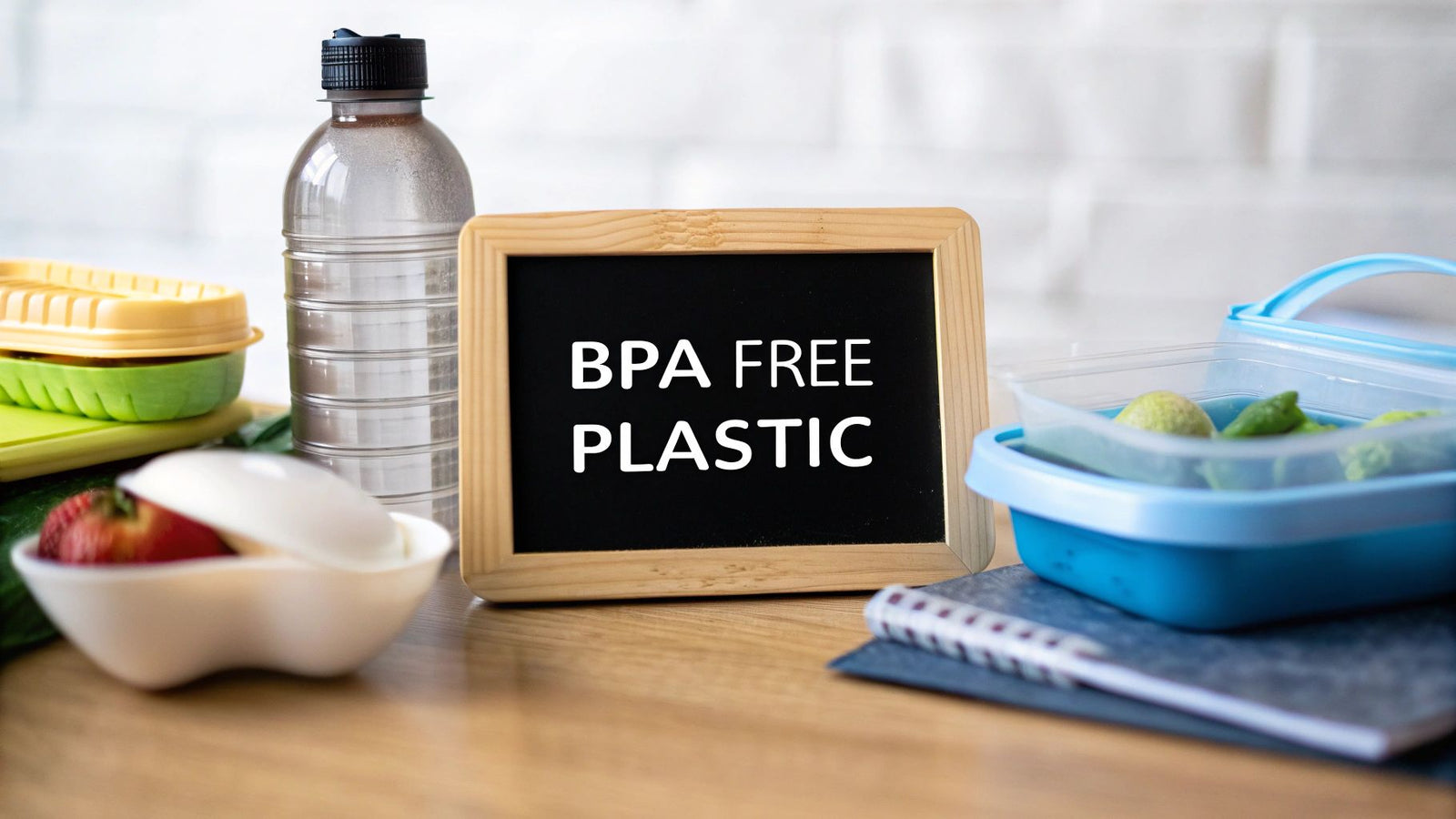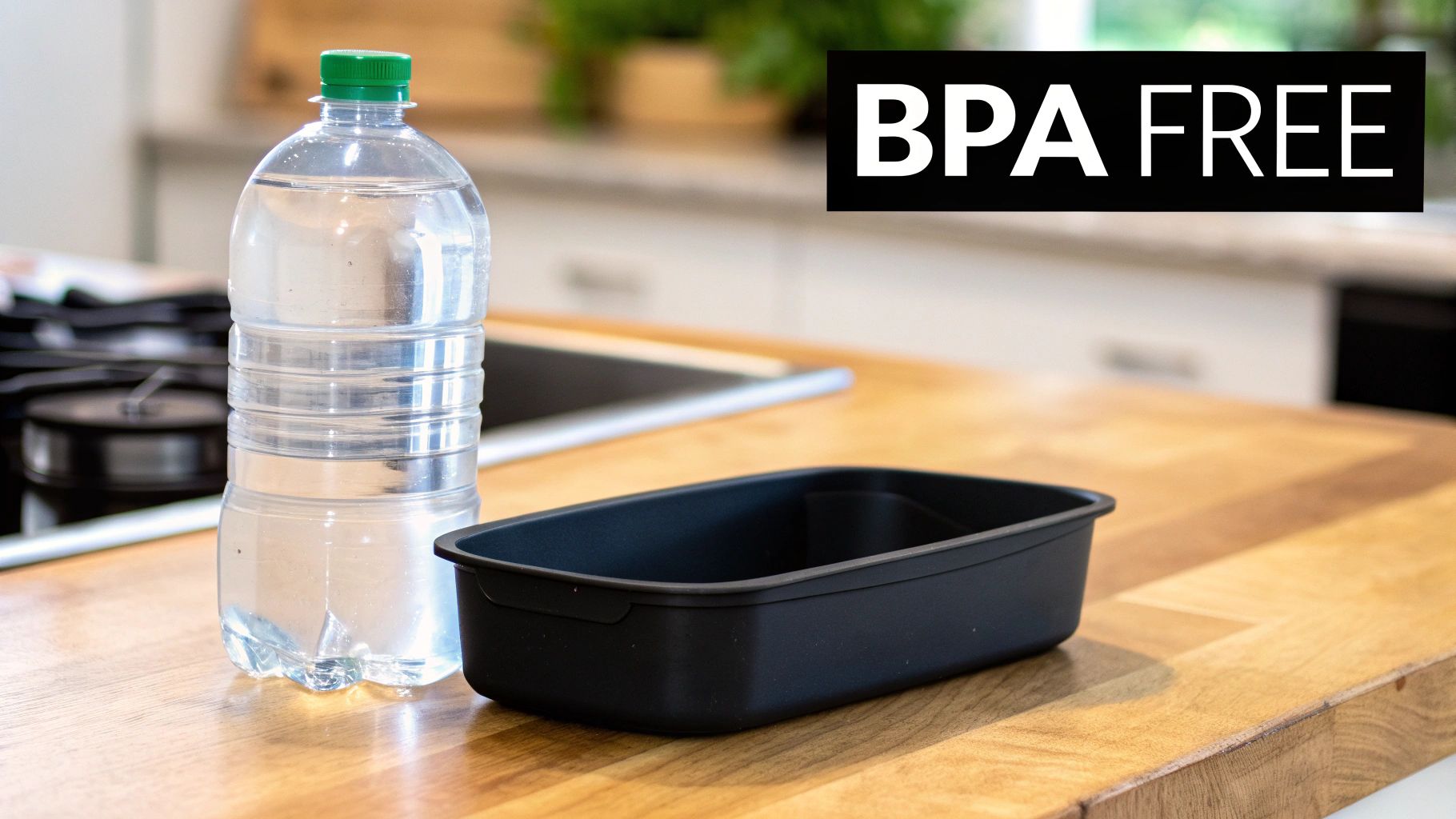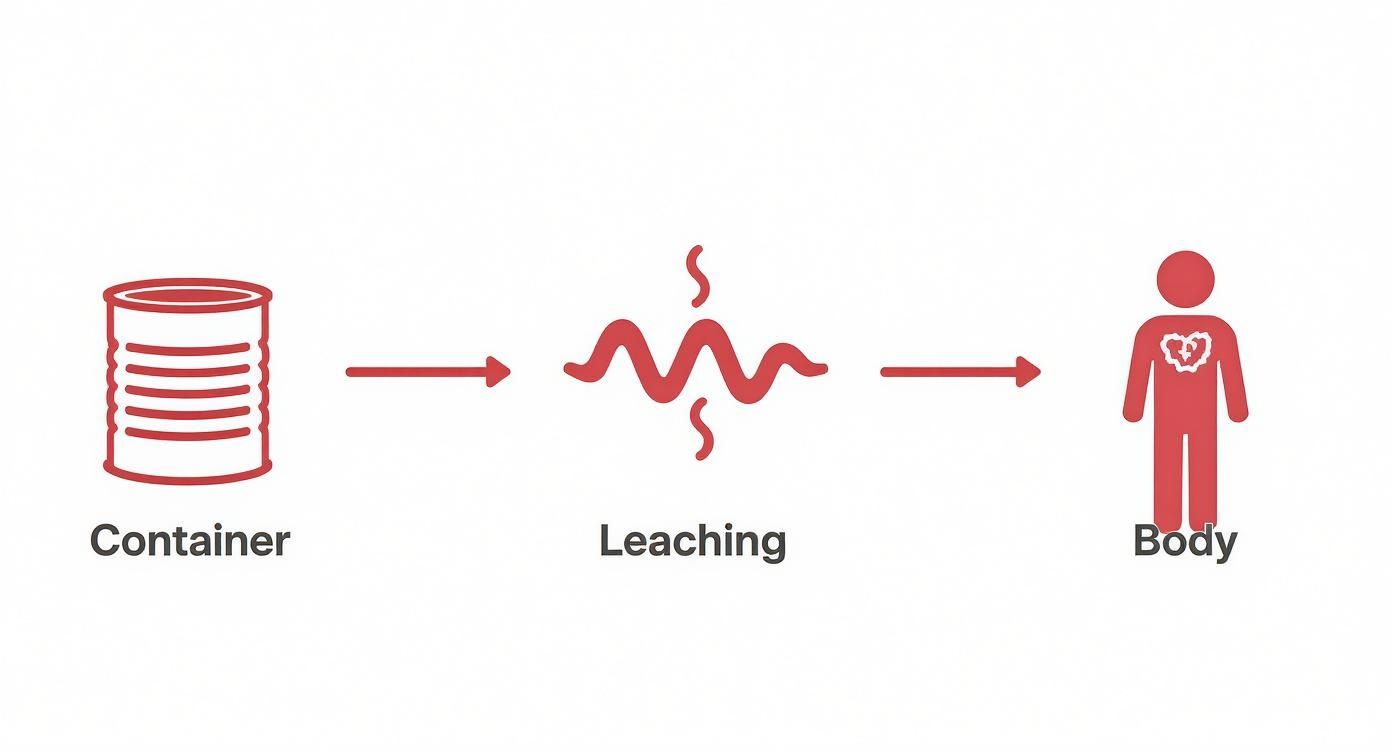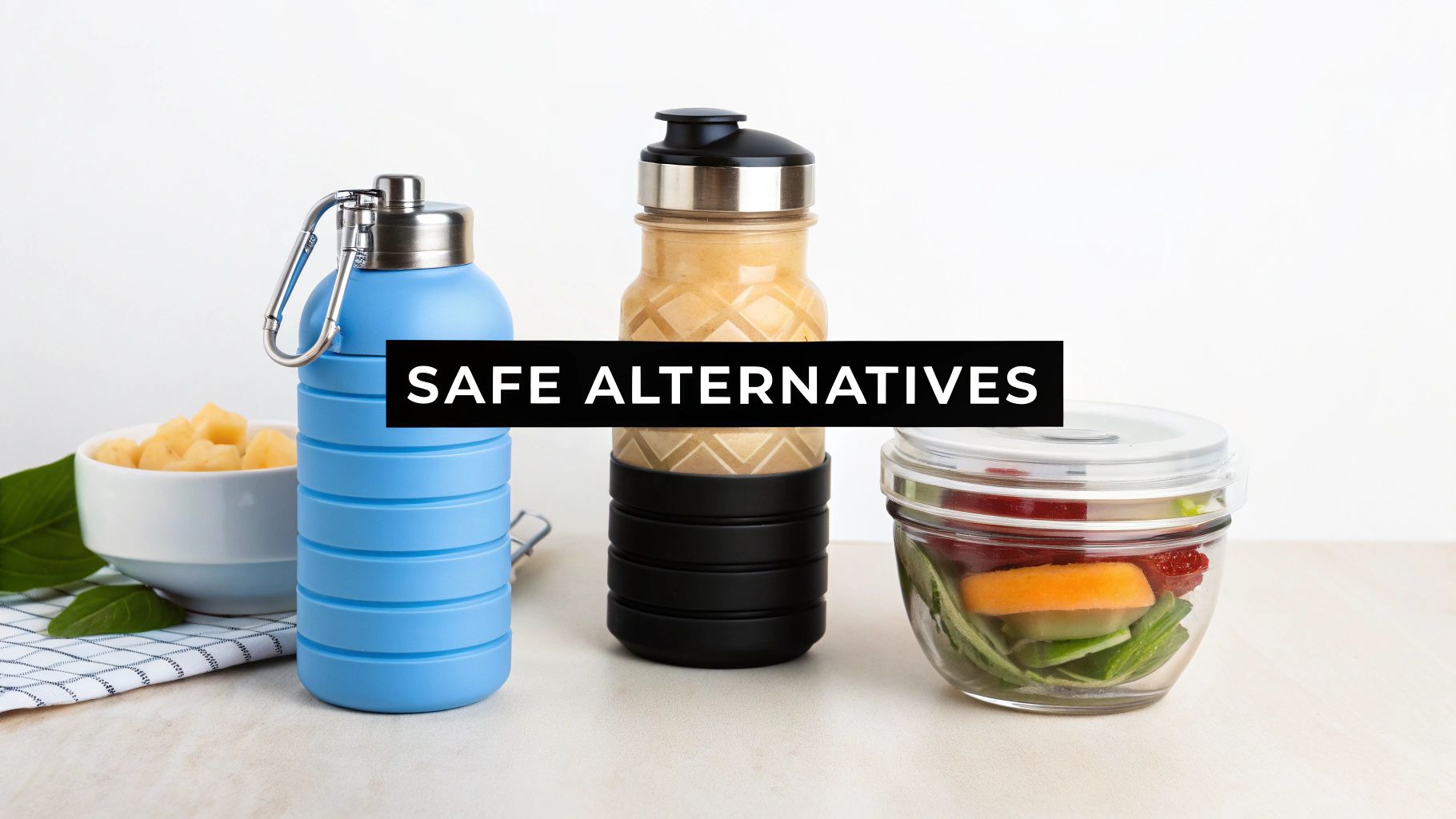What Is BPA Free Plastic and Why Does It Matter

You’ve probably seen the "BPA Free" label on everything from water bottles to food containers. It’s a common sight these days, but what does it really mean for you and your family? Let's break it down.
At its core, "BPA free" simply means a product was made without Bisphenol-A, an industrial chemical often used to make certain plastics—like polycarbonate—hard and clear. Think of it as a specific ingredient in a recipe. A BPA-free product just uses a different, safer recipe altogether, or it's made from a material that never needed that ingredient in the first place, like the food-grade silicone we use in all HYDAWAY products.
The Simple Answer to What Is BPA Free Plastic

So, what’s the big deal? Imagine you’re building something with LEGOs. BPA is like a special, super-strong glue used to make certain clear, rigid bricks extra tough. It does its job well, but concerns started popping up that tiny bits of this "glue" could leach out, especially when heated.
BPA-free plastic, on the other hand, is like building with different kinds of LEGOs that snap together perfectly without needing that specific glue. These alternatives are specifically chosen for items that come into contact with your food and drinks, giving you peace of mind. For example, your favorite trendy reusable tumbler from brands like Stanley or Hydro Flask is likely made from BPA-free materials like stainless steel.
Understanding the Alternatives
With growing demand for safer products, manufacturers have moved away from BPA-containing plastics. Here are the common go-tos you'll find today:
- Different Types of Plastic: Many everyday plastics, like PET (what most disposable water bottles are made of), have always been BPA-free. They simply don't require it in their chemical makeup.
- Inherently Safe Materials: This is the best-case scenario. Materials like glass, stainless steel, and food-grade silicone are naturally free from BPA. There's no need for chemical substitutes because they were never part of the equation.
This is exactly why we chose 100% food-grade silicone for our collapsible bottles and containers at HYDAWAY. It's a simple, reliable material that ensures your reusables are safe, right from the start.
To make it even clearer, here’s a quick look at how these materials stack up.
BPA vs BPA-Free At a Glance
This table offers a quick comparison of plastics containing BPA and their BPA-free counterparts, highlighting common products and key characteristics.
| Characteristic | Plastics with BPA (e.g., Polycarbonate) | BPA-Free Plastics (e.g., PET, Silicone) |
|---|---|---|
| Common Products | Older hard plastic reusable bottles, some food storage containers, can linings | Disposable water bottles, food-grade silicone containers, stainless steel tumblers, glass jars |
| Key Property | Rigid, shatter-resistant, clear | Flexible, durable, or rigid depending on the material; chosen for food-contact safety |
| Health Concern | Potential for BPA to leach into food/drink, especially with heat | No BPA to leach; materials are selected for stability and non-toxicity |
| Primary Use Case | Durable goods requiring high impact strength | Food and beverage storage, drinkware, flexible containers, and single-use packaging |
Ultimately, choosing BPA-free isn't just about dodging a single chemical. It’s about making a conscious choice for products designed with health and safety as the top priority.
Choosing BPA-free isn't just about avoiding one chemical; it's about consciously selecting products designed with your health and safety as the top priority.
For a parent packing lunches or a traveler trying to stay hydrated on the go, this distinction matters. Instead of grabbing a disposable bottle not meant for long-term use, you can confidently fill a HYDAWAY bottle knowing it's not only durable and convenient but also made from a material certified to be free of harmful chemicals. It’s one less thing to worry about in a busy day.
Why BPA Is a Health Concern
So, what's the big deal about one little chemical? Why does avoiding it in your plastic matter so much?
It all comes down to a process called leaching. BPA can actually seep out of containers and into the food and drinks they're holding. This gets even worse when the plastic is heated up—think microwaving a container or leaving a water bottle to bake in a hot car.
Once that BPA gets into your system, it starts causing trouble. Scientists call it an "endocrine disruptor." Here's a simple way to picture it: Think of your body’s hormone system as a series of locks (receptors) that need very specific keys (hormones) to function correctly. BPA is basically a master counterfeiter; it looks and acts so much like the hormone estrogen that it can fit into some of those locks.
When this happens, it can really confuse your body. The wrong key in the lock sends mixed signals that mess with all sorts of important processes.
By mimicking the body's natural hormones, BPA can potentially disrupt the delicate balance of your endocrine system, which is responsible for regulating metabolism, growth, and reproduction.
This potential for disruption is exactly why health organizations have raised red flags about its effects, especially for the most vulnerable among us.
Who Is Most at Risk
While BPA exposure is a concern for everyone, it’s particularly worrying for developing bodies. The risk of hormonal interference is a major issue for:
- Infants and Young Children: Their systems are still under construction, which makes them much more sensitive to anything that meddles with their hormones. This is precisely why you saw a massive regulatory push to ban BPA in baby bottles and sippy cups across the U.S. and E.U.
- Pregnant Individuals: Exposure during pregnancy is a big concern because it could potentially impact the development of the fetus.
These health worries have kicked off a huge global shift in how we buy and what companies make. People are now actively looking for safer alternatives, not just for themselves but for their families.
The market numbers tell the story. The global BPA-free cans market was worth around $7.51 billion in 2023 and is expected to soar past $10 billion by 2030. That's not just a trend; it's a clear signal that both shoppers and regulators are getting serious about cutting down on BPA exposure. You can read more about the research behind these market trends to see just how big this movement has become.
This is where a simple, conscious choice can make a real difference. When you opt for a reusable solution like a HYDAWAY collapsible bottle, you’re choosing a product made from certified food-grade silicone, which is naturally BPA-free. It's a small change that offers huge peace of mind—whether you're a parent packing a school lunch or an adventurer exploring a new city, you know your hydration is safe and worry-free.
How to Identify BPA Free Products
Walking down the grocery aisle trying to find BPA-free products can feel like a surprise quiz, but a few simple tricks can turn you into a pro shopper. Once you know what to look for, making healthy choices for you and your family is a lot easier than you might think.
The most obvious clue is looking for a clear "BPA-Free" label right on the product or its packaging. Brands know that people are actively looking for safer options, so they often plaster this feature front-and-center on everything from reusable water bottles to food storage containers.
This infographic breaks down how BPA can actually move from a container into your body, which really drives home the importance of choosing safer materials.

As the visual shows, leaching is the main way we're exposed. That’s exactly why the container you choose matters so much.
Become a Plastic Detective
But what if there’s no label? You can still figure out if a plastic is BPA-free by checking the resin identification code. This is that little number stamped inside the triangle-shaped recycling symbol, usually hiding on the bottom of a plastic item. That code tells you exactly what kind of plastic you’re holding.
While it’s not a flawless system, it’s a fantastic rule of thumb for making quick decisions in the store.
Think of the resin code as a quick reference guide. By knowing which numbers are generally safe, you can seriously cut down your chances of accidentally bringing home a product made with BPA.
Here's a simple guide to help you crack the codes:
- Generally Safe Plastics (BPA-Free): Look for codes #1 (PET), #2 (HDPE), #4 (LDPE), and #5 (PP). These are the workhorses of food and beverage packaging and don't contain BPA.
- Plastics to Approach with Caution: The main one to watch out for is #7 (OTHER). This category is a catch-all for various plastics, and that includes polycarbonate—a primary source of BPA. While not all #7 plastics have BPA, it’s best to be wary if the product doesn’t specifically say "BPA-Free."
Actionable Tips for Everyday Life
Beyond just checking labels and codes, you can weave a few simple habits into your daily routine to minimize BPA exposure and make safer choices for your family.
-
Prioritize Inherently Safe Materials: Whenever you can, opt for containers made from glass, stainless steel, or food-grade silicone for your food and drinks. These materials are naturally free of BPA and other plastic additives, giving you total peace of mind. For example, packing your lunch in a HYDAWAY silicone food container is a simple swap that makes a big difference.
-
Avoid Microwaving Plastic: Heat can make chemicals leach out more easily. You should never microwave food in a plastic container unless it’s explicitly marked "microwave-safe." The absolute safest bet is to always transfer food to a glass or ceramic dish before you heat it.
-
Choose High-Quality Reusables: Go for durable, well-made reusable products from brands that are open and honest about their materials. For instance, all HYDAWAY collapsible bottles are made from third-party certified, food-grade silicone, which means they are completely free of BPA, phthalates, and other nasty chemicals. Their collapsible design makes them perfect for busy lives, easily fitting into a gym bag, a student's backpack, or a carry-on without taking up space.
The market for BPA-free materials is blowing up, with options like PET (polyethylene terephthalate) leading the charge. PET's reputation for safety and recyclability is why you see it used for everything from single-use beverage bottles to containers for your favorite peanut butter.
Choosing Your BPA Free Alternatives
Making the switch to a BPA-free lifestyle is easier—and more stylish—than you might think. The market is packed with fantastic, modern alternatives for your kitchen, your daily commute, and even your biggest adventures. So, let's move past what to avoid and start exploring the safe, high-quality options you can confidently bring into your home.
From food containers to reusable coffee cups, the choices are vast. You no longer have to sacrifice convenience for peace of mind. Brands have stepped up, designing thoughtful products that are both incredibly functional and completely free from harmful chemicals.

Integrating Safer Choices Into Your Daily Life
Adopting BPA-free habits can fit seamlessly into any routine. It really just comes down to making small, practical swaps that add up to a big impact on your health.
For instance, a parent can pack their child’s lunch in a HYDAWAY collapsible food container, knowing it’s made from certified food-grade silicone. It’s a simple choice that completely removes any worry about chemicals leaching into their food. You can dive deeper into the benefits of using a collapsible silicone food container for meal prep and storage.
Or think about a traveler slipping a HYDAWAY collapsible bottle into their carry-on. It saves precious space and means they can skip the single-use plastic bottles at the airport. This isn't just a win for their health; it’s a smart, sustainable move that cuts down on waste and saves a few bucks on overpriced airport water.
By choosing high-quality reusables, you're not just avoiding BPA; you're investing in durable products that support an active, health-conscious life without compromising on convenience or style.
What to Look for in a BPA Free Product
When you're shopping for new gear, keep an eye out for these key materials. They are inherently BPA-free and offer awesome performance for everyday life.
- Food-Grade Silicone: This is a top-tier choice. It's flexible, super durable, and handles hot and cold temperatures like a champ. It’s the material we trust for all HYDAWAY products because it’s certified safe and built to last for years of adventures.
- Stainless Steel: Known for its pure strength and the fact that it never holds onto old flavors (goodbye, lingering coffee taste!), stainless steel is a classic choice for water bottles, thermoses, and food jars.
- Glass: While it can be a bit heavier, glass is perfect for food storage at home. It’s non-porous, won’t stain, and can usually go straight from the fridge to the microwave without a problem.
Each of these materials provides a reliable answer to the whole what is bpa free plastic question by offering a complete, worry-free alternative. Picking products like HYDAWAY's means you get the best of both worlds: the safety of certified materials and the clever design needed for a life on the move. Whether you’re commuting to work, hiking a mountain, or just managing family life, it's easier than ever to live well.
The Global Shift Toward Safer Plastics
The move toward BPA-free products isn't just a passing trend—it's a massive global movement. As more research came to light about the potential health risks of BPA, consumers everywhere started demanding safer materials for their families. It created a powerful ripple effect across just about every industry you can think of.
This groundswell of public concern forced manufacturers to innovate and pivot away from traditional plastics like polycarbonate. It’s a classic case of demand driving supply. Once shoppers began actively looking for the "BPA-Free" label, brands had to respond with safer, more transparent options or risk getting left on the shelf.
And this isn't just a hunch. The global market for plastics is rapidly shifting, with consumers and industries moving towards safer, more sustainable options. This widespread change is a direct result of people like you making informed choices about the products you bring into your home.
Governments Step In To Validate Concerns
The voice of the consumer got so loud that governments around the world had no choice but to listen. Regulatory bodies started stepping in to validate these public health concerns with real action, turning a market trend into established law.
This official intervention was a game-changer, giving a powerful endorsement to the science highlighting BPA's risks. Some of the key regulatory moves that cemented this global shift include:
- Bans on Baby Products: Countries like the United States, Canada, and the entire European Union led the charge by banning BPA from baby bottles, sippy cups, and infant formula packaging. It was a critical first step, acknowledging how vulnerable infants and children are.
- Restrictions on Food Packaging: Many regions have since expanded these rules to cover all materials that come into contact with food. This is especially true for items meant for heating, since high temperatures can speed up chemical leaching.
- Mandatory Labeling Laws: Some governments now require clear labeling, making it easy for consumers to spot BPA-free products and make choices that align with their health priorities.
These regulations were a turning point. They were an official acknowledgment that the concerns about BPA were valid and that protecting public health meant changing how everyday products were made.
Your Choice is Part of a Worldwide Effort
This one-two punch of consumer demand and government regulation has created a whole new standard for safety. It shows that your individual choice to use a HYDAWAY bottle or food container is part of a much bigger story.
When you opt for a product made from certified food-grade silicone, you're joining a worldwide effort to create a healthier, safer world for everyone. It's a proactive step that not only protects your own well-being but also throws your support behind companies committed to doing things the right way. Your HYDAWAY bottle makes it simple to act on these values every day—its collapsible design ensures you always have a safe, reusable option on hand, whether you're at the office, the gym, or exploring a new country.
Got Questions About Going BPA-Free?
As you start making more health-conscious choices, a few questions are bound to pop up. Switching to BPA-free products is a huge step in the right direction, but it's totally normal to have some lingering "what ifs." We've got you covered with clear, straightforward answers to the most common questions, so you can feel 100% confident in your choices.
Think of this as your go-to guide for clearing up any final misconceptions and tackling those practical, everyday concerns.
Is "BPA-Free" Always a Guarantee of Safety?
This is a great question. While a “BPA-Free” label is a good start, it doesn’t always tell the whole story. It confirms the product doesn't contain Bisphenol-A, but some manufacturers simply swap it out for similar chemicals like Bisphenol-S (BPS) or Bisphenol-F (BPF). Early studies suggest these substitutes might not be any better for our health.
This is where choosing products from brands that are transparent about their materials gives you an extra layer of assurance. For instance, HYDAWAY uses third-party certified, food-grade silicone—a material that’s naturally free from BPA, BPS, BPF, and all other bisphenols. It’s a choice that ensures you’re avoiding a whole class of potentially harmful chemicals, not just one.
Aren't Single-Use Bottles Also BPA-Free? Why Are Reusables Better?
It's true that most single-use water bottles, typically made from #1 PET plastic, are BPA-free. But here’s the catch: they are absolutely not designed for reuse. Over time, these flimsy bottles develop tiny cracks and scratches that are a nightmare to clean, quickly becoming a breeding ground for bacteria. They can also break down and potentially leach other unwanted chemicals into your water.
A high-quality, durable reusable bottle is a much smarter choice. It’s built to last for thousands of refills, it’s far easier to clean properly, and it saves you a ton of money in the long run. Most importantly, it drastically cuts down on plastic waste, making it a healthier decision for both you and the planet.
Can I Microwave or Dishwash My BPA-Free Containers?
Heat is a major factor when it comes to chemical leaching, even from some BPA-free plastics. You should always check for a "microwave-safe" or "dishwasher-safe" label before putting any plastic container near high temperatures. If you can't find a label, your safest bet is to wash it by hand and keep it out of the microwave entirely.
When you need to heat up food, glass or ceramic containers are always the safest option. For easy, worry-free cleaning, look for durable materials like the food-grade silicone used in HYDAWAY products. They're designed to be top-rack dishwasher safe, making sanitation simple and convenient for your busy schedule.
How Do Products Like HYDAWAY Actually Help the Planet?
Choosing a reusable BPA-free product like a HYDAWAY bottle is a powerful way to protect the environment. Every single time you fill it up, you’re preventing another single-use plastic bottle from ending up in a landfill or, even worse, our oceans and waterways.
Over a single year, just one person can save hundreds of plastic bottles from becoming trash. The brilliantly collapsible design of HYDAWAY bottles makes them incredibly easy to stash in a pocket or bag, reinforcing the sustainable habit of reuse. It’s a simple action that helps protect our planet, one refill at a time.
Ready to embrace a healthier, more sustainable lifestyle? The award-winning collapsible gear from HYDAWAY makes it easy to stay hydrated on the go without compromising on safety or convenience. Explore our full collection of BPA-free bottles, bowls, and travel accessories at https://myhydaway.com.



